|
January 2022 - April 2022 |
| |
|
|
 |
|
 |
| |
Publisher: Chairman Jian-Jang Huang Editors: Professor
Snow H. Tseng, Ms. Hsiao-wen Lin June 30, 2022 |
| |
|
 |
|
Congratulations to Si-Tong Liu, Master Student of Prof. Guo-Dung Su, for being awarded "TPS 2022 Best Poster Award."
Poster Title: Heterodyne Sum-Frequency Surface Phonon Spectroscopy
Congratulations to Prof. Snow H. Tseng for being awarded "Editor's Pick" for his publication in "Biomedical Optics Express," in collaboration with UCIrvine Beckman Laser Institute.
Thesis Title: Corneal transparency and scleral opacity arises from the nanoarchitecture of the constituent collagen fibrils
Link: https://doi.org/10.1364/BOE.444832
Congratulations to Prof. Chih-I Wu for the honor of being awarded "Chinese Institute of Engineers Distinguished Professor 2022."
Congratulations to Prof. Yuh-Renn Wu for being awarded "Editor's Pick" for his publication in the "Journal of Applied Physics."
Thesis Title: Investigating the high field transport properties of Janus WSSe and MoSSe by DFT analysis and Monte Carlo simulations
Links:
https://aip.scitation.org/topic/collections/editors-pick?SeriesKey=jap
https://doi.org/10.1063/5.0088593
|
|
 |
|
 |
|
| |
|
 |
|
October “GIPO Colloquium” Highlights |
|
|
2:20 pm, October 1 (Fri.), 2021 |
|
Speaker: |
Prof. Ting-Chang Chang (Chair Professor, National Sun Yat-Sen University) |
|
Topic: |
Low temperature defect passivation technology for semiconductor electronic devices |
| |
|
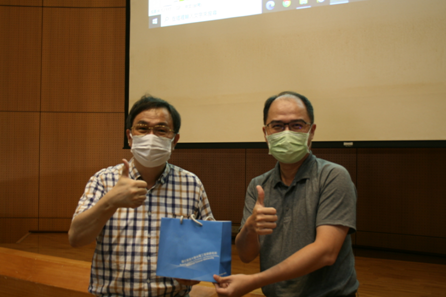 |
|
Prof. Ting-Chang Chang (left) and Prof. Jian-Jang
Huang (right) |
|
|
|
2:20 pm, October 15 (Fri.), 2021 |
|
Speaker: |
Jerry Chen
(Chairman, Brain Navi Biotechnology Co., Ltd.) |
|
Topic: |
Robots in OR, the Future is NOW |
|
|
|
|
|
2:20
pm, October 22 (Fri.), 2021 |
|
Speaker: |
Dr. Chii-Dong Chen
(Institute of Physics, Academia Sinica) |
|
Topic: |
Building a Superconducting Quantum Computer |
|
|
|
November “GIPO Colloquium”
Highlights |
|
|
2:20
pm, November 5 (Fri.), 2021 |
|
Speaker: |
Prof. Kuan-Neng Chen
(Chair Professor, Institute of Electronics, National Yang Ming Chiao Tung University) |
|
Topic: |
3D IC and Advanced Packaging |
| |
|
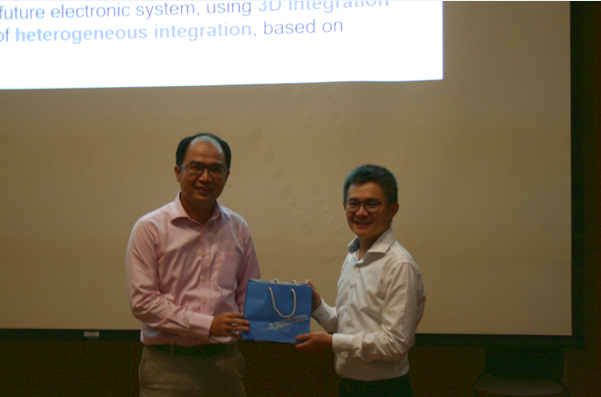 |
|
Prof. Kuan-Neng Chen (right) and Prof. Jian-Jang
Huang (left) |
|
|
|
2:20
pm, November 12 (Fri.), 2021 |
|
Speaker: |
Dr. Jeffery Chiu
(CEO, Ansforce Inc.) |
|
Topic:
|
Semiconductor foundry and applications in advanced packaging technology |
|
|
|
|
|
2:20
pm, November 19 (Fri.), 2021 |
|
Speaker: |
Dr. Patrick Hsu
(FocalTech) |
|
Topic: |
IC design for high speed transmission of voice, image, data, and power |
|
|
|
December “GIPO Colloquium”
Highlights |
|
|
2:20
pm, December 10 (Fri.), 2021 |
|
Speaker: |
Prof. Wen-Jong Wu
(Department of Engineering Science and Ocean Engineering, National Taiwan University) |
|
Topic:
|
My IoT Journey. From research, startup to tech jobs. |
|
|
|
|
|
2:20
pm, December 17 (Fri.), 2021 |
|
Speaker: |
Dr. Li-Jen Hsiao
(National Chung-Shan Institute of Science and Technology) |
|
Topic:
|
Beyond the Lab |
|
|
|
January “GIPO Colloquium”
Highlights |
|
|
2:20
pm, January 14 (Fri.), 2022 |
|
Speaker: |
Cheng-Che Hsieh
(IBM Infrastructure Specialist) |
|
Topic:
|
Switching Career - Life Changing Decisions |
|
 |
|
 |
|
| |
|
 |
|
~ Next Generation
Metaverse Optoelectronics
Technology ~
(April 1, 2022, Barry Lam Hall, National Taiwan Univeristy)
Composed by
Yu-Han Huang,
Hui-Kai Lin,
Chee-Keong Yee
The "Next Generation Metaverse
Optoelectronics Technology" forum was held on
April 1 in Barry Lam Hall, NTU. In the year
2021, Mark Zuckerberg the co-founder of Facebook
coined the term metaverse, combining the two
words "meta" and "verse". Since then, the term
metaverse quickly caught attention on a global
scale, and became one of the most popular search
terms for the year. Be it the academic scene or
the industrial scene, or even in everyday chats
and exchanges, it is obvious that most
individuals associate feelings of anticipation
and excitement with it when thinking about the
idea of the metaverse.
This forum is a combined effort by IEEE
Photonics Society Taipei Chapter and National
Taiwan University GIPO, inviting scholars from
all fields to present the fruits of their
research and experiences. It is our hope that
future collaborations and opportunities can be
sparked through discussions and exchanges from
forerunners and experts in metaverse related
fields and technology, giving rise to new ideas
and inspirations.
|
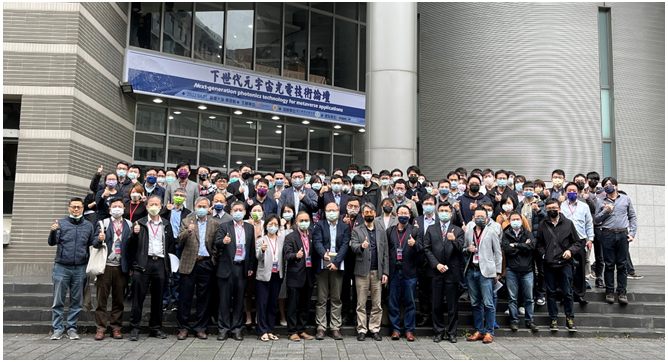 |
|
Group
photo |
|
Many aspects of the key
technology in the metaverse
field are firmly rooted in
optoelectronics, such as
display components (e.g.
Micro-LED), optical
elements, 3D sensor
components (e.g. VCSEL and
PCSEL). Many of the
technologies are currently
undergoing rapid research
and development at an
increasing rate, extending
and completing the industry
chain towards both the
supply end and the user end.
On the day of the forum, many
distinguished professors including Prof.
Ray-Hua Horng, Prof. Charles W. Tu,
Prof. Tien-Chang Lu, and Prof. Hsiang-Chieh
Lee gave us a brief primer on the basics
and fundaments on the topics, and also
many possible future developments. From
ITRI, Dr. Yen-Hsiang Fang gave us a
brief talk on VR/AR/MR, and the future
of display technology. Many
representatives from various enterprises
such as PlayNitride, SEMICON, Jorjin,
Ansys, GIS, AMS-OSRAM, and Synopsys also
participated in the presentation.
Through the exchange, it become apparent
that each participant have their own
concerns and goals. Some focused on
pushing the display fabrication towards
larger display dimensions, while others
focused on the developments of
increasingly smaller components, and it
was precisely this diversity that gave
meaning to this forum.
This forum gave many experts and scholars and students and researchers an open opportunity to discuss and bounce ideas and thoughts back and forth. It is our belief that the multiverse will eventually become closely associated with our work and life. Infinite possibilities. This forum itself represented a small step towards the future. If we combine our expertise and strengths, our state of the art fabrication capabilities and cutting edge research developments, we can push Taiwan towards the pinnacle of technology. The future is infinite.
|
|
 |
|
 |
|
| |
|
 |
Coherent Tri-mode FPLD with SCM of 80 Gbit/s OFDM for 75-km Long-Reach MMWoF at 28 GHz
Professor Gong-Ru Lin’s Laboratory
Graduate Institute of Photonics and
Optoelectronics, National Taiwan University
A novel FPLD with orthogonal polarized tri-mode under single-carrier modulation (SCM) for chromatic dispersion suppression is employed to demonstrate 28-GHz remote optical heterodyne in millimeter-wave-carrier-over-fiber (MMWoF) for 75-km long-reach wireline and wireless transmission at 80 and 30 Gbit/s under bit-loaded M-QAM OFDM with spectral usage efficiency up to 10 bit/s/Hz. The 28-GHz and 75-km long-reach MMWoF constructed by an orthogonal tri-mode LD with SCM is exhibited in Fig. 1. A single-polarization light source generated from a DFBLD was adjusted a 45o polarization between the light source and the Mach-Zehnder modulator (MZM). A 28-GHz LO sinusoidal wave was modulated onto the single-polarization light source by a MZM with null-point operation for the orthogonal tri-mode master source generation (point (a)). The orthogonal tri-mode master was divided into two paths by an optical coupler. One path of this master source injection-locked a Fabry-Perot LD (FPLD) only supporting the TE polarization. The side modes of the tri-mode source with the TM polarization would be suppressed in the FPLD cavity, which implements the SCM (point (b)). For another path, the central carrier of the tri-mode source was suppressed by a polarizer (node (c)). The injection-locked carrier and central-carrier suppressed side-modes source were orthogonal combined by another optical coupler to form an orthogonal tri-mode optical carrier with SCM (point (d)). The narrow-band 64- to 1024-QAM OFDM with the bandwidth from 166 to 100 MHz was generated by an 18-GSa/s AWG. The bit-loaded QAM-OFDM data was modulated on the injection-locked carrier with side-mode suppression by the FPLD as an optical amplifier and modulator.
|
 |
|
Figure 1. The microscopic image, package photo, and network scheme of a tri-mode FPLD with SCM of M-QAM OFDM for 75-km long-reach MMWoF. |
To maximize the transmission capacity and meet the 5G standard, the multi-channel bit-loaded M-QAM OFDM with 100-MHz/channel bandwidth is employed. The maximal channel number in 8-GHz bandwidth is obtained as 80, and the first channel is set from 70 MHz. After demodulation, the SNR spectra of each narrow-band bit-loaded M-QAM OFDM data and the wide-band 64-QAM OFDM data delivered by orthogonal tri-mode optical carrier after 75-km transmission are exhibited in Fig. 2. Figure
3 also shows the related constellation plots for the narrow-band bit-loaded M-QAM OFDM data. The maximal bandwidth and raw data rate of the delivered wide-band 64-QAM OFDM, which can pass the FEC limit, are obtained as 8 GHz and 48 Gbit/s, respectively. For the narrow-band case, the total raw data rate of the delivered multi-channel bit-loaded M-QAM OFDM data is evaluated as 10 (1024 QAM)
x6 GHz+9 (512 QAM) x2.2 GHz=80 Gbit/s.
|
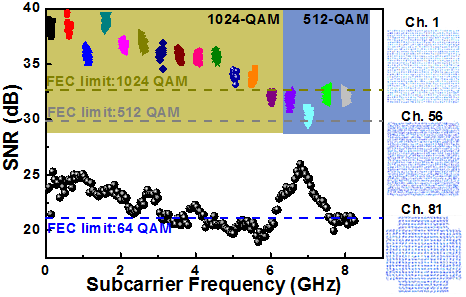 |
|
Figure 2. The SNR spectra of narrow-band M-QAM OFDM data and wide-band 64-QAM OFDM data delivered by orthogonal tri-mode optical carrier after 75-km transmission. |
|
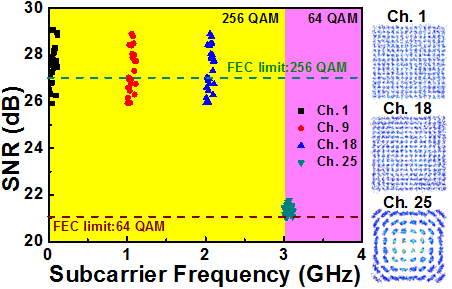 |
|
Figure 3. The frequency spectra of the delivered multi-channel M-QAM OFDM by beat 28-GHz MMW carrier after 10-m free space transmission. |
The multi-channel bit-loaded M-QAM OFDM data with the same channel bandwidth is also employed at wireless transmission. After the same demodulation, the SNR spectra of each narrow-band M-QAM OFDM data with the related constellation plots are exhibited in Fig. 3. The SNR of the 1st channel is measured as 27.2 dB to pass the 256-QAM FEC limitation with a BER
of 3.1x10-3 and an EVM of 4.4%. When increasing the channel to 25, the SNR is degraded to 22.5 dB, which can also pass the 64-QAM FEC limitation with a BER of 1.1x10-3 and an EVM of 7.5%. Therefore, the total raw data rate of the delivered multi-channel bit-loaded M-QAM OFDM data is evaluated as 8 (256 QAM)
x3 GHz+6 (64 QAM) x1 GHz=30 Gbit/s.
Minority Carrier Decay Length Extraction from Scanning Photocurrent Profiles in Two-Dimensional Carrier Transport Structures
Professor Ming-Hua Mao’s Laboratory
Graduate Institute of Photonics and
Optoelectronics, National Taiwan University
Carrier transport was studied both numerically and experimentally using scanning photocurrent microscopy (SPCM) in two-dimensional (2D) transport structures, where the structure size in the third dimension is much smaller than the diffusion length and electrodes cover the whole terminal on both sides. The scanning photocurrent simulation results surprisingly showed almost identical profiles from structures with different widths. The simulation results indicate that the integrated carrier distribution in the 2D transport structures with finite width can be well described by a simple-exponential-decay function with the carrier decay length as the fitting parameter, just like in the 1D transport structures. Furthermore, our simulation results demonstrate that the scanning photocurrent profiles in the ohmic- or Schottky-contact three-dimensional (3D) transport structures with electrodes covering the whole terminal on both sides will reduce to those described by the corresponding 1D fitting formulae. Finally, experimental SPCM on a p-type InGaAs air-bridge two-terminal thin-film device was carried out. This study allows us to extract the minority carrier decay length and to obtain the mobility-lifetime product which can be used to evaluate the performance of 2D carrier transport devices. This work has been published in
Scientific Reports:
Yu‑Chien Wei, Cheng‑Hao Chu, and Ming‑Hua Mao*, “Minority Carrier Decay Length Extraction from Scanning Photocurrent Profiles in Two-Dimensional Carrier Transport Structures,”
Scientific Reports, 11, 21863, (2021).
|
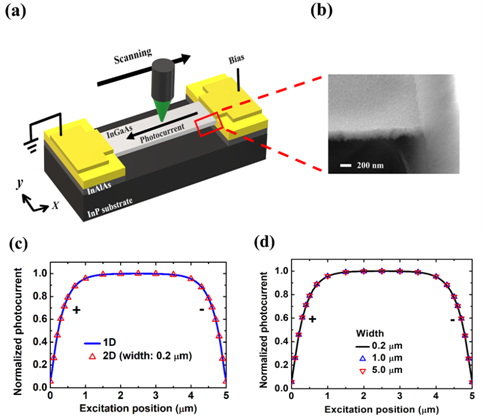 |
|
Figure 1. (a) Schematic of the SPCM setup in an InGaAs air-bridge two-terminal thin-film device. (b) SEM images for one side of the measured InGaAs air-bridge two-terminal thin-film device. (c) Scanning photocurrent profile of the 0.2 μm wide case compared with that of the 1D transport structure. (d) Scanning photocurrent profiles with different widths. |
Reflective 3D Pixel Configuration for Enhancing Efficiency of Emissive Displays
Professor Chung-Chih Wu
Graduate Institute of
Photonics and
Optoelectronics,
National Taiwan
University
Although active-matrix light-emitting diode displays (AM-LEDs) have been widely applied, effective optical out-coupling techniques possessing both integration compatibility and image quality remain highly desired for further improving their efficiency and power consumption performances . In our studies, a 3-dimensional (3D) reflective pixel structure filled with a patterned high-index material was proposed for boosting light extraction efficiency of common top-emitting AM-LED pixel devices. Using the OLEDs, we conducted experimental studies on the proposed 3D pixel configuration to validate the simulation and design. 3D OLED pixel devices with varied pixel dimensions were implemented and their structures, electrical properties, efficiencies, and EL characteristics were characterized. Significant efficiency gains were obtained with the mm-scale reflective 3D pixel devices and experiment results well corroborated multiscale optical simulation results, confirming effectiveness of the 3D LED pixel for enhancing light extraction of emissive displays.
|
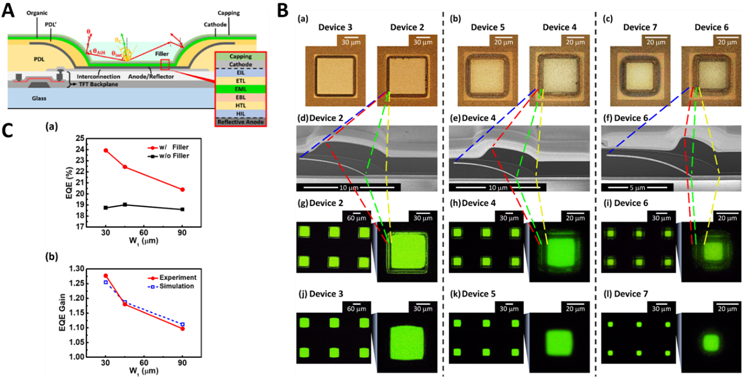 |
|
Figure 1.
(A) 3D reflective concave OLED pixel structure having the reflective bank slope surface and the patterned high-index filler.
(B) Characteristics of of pixel devices
2-7 (2/4/6 patterned filler pixels and
3/5/7 non-filler conventional pixels) observed by optical microscopy and cross-sectional SEM (2/4/6).
(C) EQEs and EQE gain (filler vs. non-filler device) of pixel array devices (devices
2-7) as a function of the PDL opening size W1, for both filler and non-filler reference devices. |
PSTD Simulation Analysis of the
Transparency and Opacity of Biological
Tissues
Professor
Snow H. Tseng's Laboratory
Graduate Institute of
Photonics and
Optoelectronics, National
Taiwan University
Abstract: Certain human biological tissues appear transparent or opaque, yet, the cause of such optical properties are yet to be determined. Here we use the pseudospectral time-domain (PSTD) simulation technique to model light propagation through scleral/corneal tissue and analyze the optical characteristics due to geometrical structure. Research findings show that light scattering may account for scleral opacity and corneal transparency.
Introduction
To date, hypotheses for the transparency/opacity of corneal/scleral tissues have not been analyzed based upon rigorous simulation of electromagnetic propagation of light. In this study we model corneal/scleral tissues to rigorously model light propagation using Maxwell’s equations. Our goal is to investigate the cause that may lead to corneal transparency and scleral opacity.
|
 |
|
Figure:
Intensity distribution of a CW plane wave (λ= 400 nm) through (a) vacuum (b) corneal and (c) scleral media. The corneal medium supports light propagation in a manner similar to vacuum. By contrast, the scleral geometry hinders light propagation. Differences in light transmittance between corneal and scleral media becomes more pronounced with increased media thickness. |
|
|
|
 |
|
 |
|
| |
|
|
 |
|
 |
|
|
|